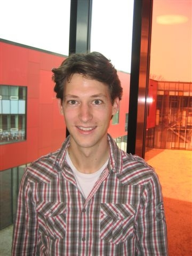Geometrical Scaling Effects on Carrier Transport in Ultrathin-Body MOSFETs
Promotion date: 1. April 2011
Promotor: Prof. Dr. Jurriaan Schmitz and Prof. Dr. Luca Selmi
Assistant promotor: Dr. Ir. Ray Hueting
| The effects of reducing the channel length and the body thickness on carrier transport in ultrathin-body MOSFETs is studied. An accurate method is proposed to quantify shifts in energy band alignment, and so to assess the impact of structural quantum confinement in the ultrathin semiconductor body. A new model for the so-called ‘backscatter coefficient’ in nanoscale MOSFETs was proposed. It is shown the model provides a useful framework to help explain and predict quasi-ballistic transport phenomena in nanoscale MOSFETs. |
Was there a special moment that you remember during the thesis project?
There wasn’t one particular moment. The work progressed very well, right from the start. I guess this was the case because it connected very well to previous work, done in the master project.
After working on the electrical characterization of quantum confinement in ultrathin-body MOSFETs – having a body thickness ranging from 20 nm to only a few nanometers - I was able to put my attention towards ballistic transport, on which we collaborated with the University of Udine, Italy. It was great to be able to work together on this topic which is a very active area of research. It even resulted in a co-tutelle, a joint PhD-programme. Of course, this was a very nice extra.
We have worked on the effect of scaling of so-called ultrathin-body MOSFETs. This novel type of MOSFET is explored for application in future CMOS technology nodes. Because of the nanoscale regime, several interesting phenomena occurred.
For example, we found that in extremely thin semiconductor layers electrons seem heavier than in thicker layers. Furthermore, the average distance electrons travel, turned out to be shorter than commonly assumed. Modelling and characterization these and similar effects, is essential for the development of future CMOS technologies.
Did you have a nice exposure to your results?
Actually, yes. We published our findings in renowned journals such as: Transactions on Electron Devices and Electron Device Letters.
Furthermore, I presented parts of the work at conferences in Edinburgh, Scotland and Sevilla, Spain. Going to a conference is a very nice experience, both from a scientific as well as from a social point of view!
Was your research application driven?
This project was financially supported by NXP. Although most of the work was carried out at the University of Twente and in Udine, we collaborated on a regular basis with NXP.
For example, during a stay with NXP in Eindhoven in the summer of 2008, we investigated the thermal effects which were expected to occur in nanoscale MOSFETs. Measuring these self-heating effects turned out to be far from trivial. This work and subsequent detailed analysis in NXP, provided a clear estimate of the impact of self-heating in next generation CMOS technologies.
What are your future plans?
Now I am working in the Holst-Centre, which is a joint initiative of TNO and IMEC from Leuven, Belgium. This institute is working on flexible displays, in close collaboration with partners from industry. I find working on flexible electronics very exciting, because research is progressing very fast. And it is strongly driven by industry, giving research very clear applications.
Perhaps, one day I would like to return to academic research again. I am not sure yet. The Holst Centre is the best of both worlds, so to say: you work together in teams directly with industrial partners, the span of time is shorter and the research topics are closer to applications in the near future. Nevertheless, a scientific approach is chosen and collaboration takes place with the academic world.
What, in your opinion, is important for Mesa+ to stay successful in the future?
I think that there should be a stronger collaboration between the groups within MESA+. In the ‘CMOS’ world, for example, the link between device physics, materials science and technology becomes more and more important. Only by approaching the topic in a multidisciplinary fashion, the full potential of MESA+ is exploited.
Also, I believe, inspiration for research can be gained from industry without giving in on scientific content. Often long-term issues remain unresolved in industry since the short-term ones have higher priority.
Speaking for myself, I looked for this kind of challenges. In doing so, I experienced industry and science are not that far apart most of the time. Companies like to participate in it and are willing to open their doors. After all, during the PhD one should take the opportunity to have a look around.

